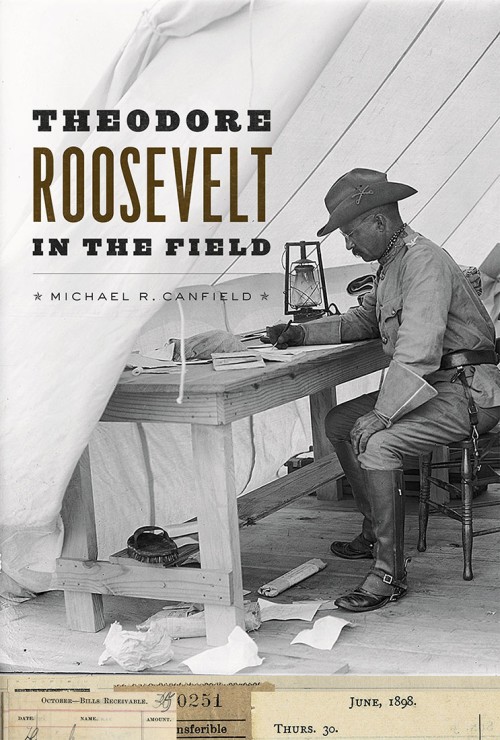by Michael R. Canfield
The University of Chicago Press, 2015
Michael R. Canfield’s Theodore Roosevelt in the Field is not so much about Roosevelt’s conservation policies or his presidency as it is about the growth and evolution of Roosevelt’s devout curiosity and untethered passion for the outdoors. He was a boy naturalist who collected, hoarded, hunted, rode horseback, explored, adventured, and kept an illustrated journal. Canfield examines Roosevelt’s life in linear fashion starting at the age of seven, when Roosevelt studied a seal carcass on lower Broadway and decided to pursue a life of science. Then Canfield moves in sequence to Harvard, where Roosevelt discovered the Maine wilderness; the years Roosevelt spent cattle-ranching in the Badlands of North Dakota; and Roosevelt’s exploits with the Rough Riders in Cuba. In his post-presidential years, Roosevelt spent a year in Africa collecting specimens for the Smithsonian and the American Museum. Then, in Amazonia, he discovered and mapped the source of Brazil’s Rio da Dúvida (“River of Doubt,” later renamed Rio Roosevelt).
When Roosevelt became president, his passions translated into a national conservation policy, much of which remains in place today.
Here’s food for thought: What if William McKinley had not been assassinated and Theodore Roosevelt never became our twenty-sixth president? Who among the next 19 presidents would have preserved from exploitation 230 million acres of federal land or have had the foresight to set aside 51 national bird refuges, which collectively morphed into the National Wildlife Refuge System? Would another national leader have created the modern National Forest System, emphasizing the conservation of forest resources? Who would have badgered Congress to pass the Antiquities Act (1906), giving presidents the power to create national monuments without the consent of Congress, before designating 18 of these monuments himself? Among them: Devil’s Tower, Muir Woods, the Petrified Forest, and the Grand Canyon. What president adored science, read and quoted Darwin, and periodically left Washington to camp with leading nature writers of the day – John Muir in Yosemite and the Grand Canyon; John Burroughs in Yellowstone and rural Virginia? Roosevelt trumpeted being at Yosemite as being “like lying in a great solemn cathedral, far vaster and more beautiful than any built by the hand of man,” and he instructed Congress, “Leave [the Grand Canyon] as it is. You cannot improve on it.” What president vacationed in Colorado hunting mountain lions, in Oklahoma hunting coyotes, and in Mississippi hunting black bears – yet also found the time to write five books while residing in the White House?
Although only snippets of dialogue grace this nearly 500-page, outdoor-themed biography, Canfield liberally quotes from his subject’s journals (including childhood entries with phonetic spelling and cave-art sketches) and from select pieces of polished work.
Camp Roosevelt, Colorado, May 1.
4:45 a.m. – Turned out. Took A snow bath. Ran one mile as an appetizer.
5:00 – Built a fire. Waked cook. Chucked a snowball down [presidential secretary] Loeb’s neck to wake him up.
5:10 – Getting pretty hungry at this time. Think I’ll have to have another cook, this one being too slow; can’t get breakfast in less than twenty minutes.
5:15 – Threw the cook into a snow drift and got breakfast myself.
At another point in the book, the President was in the midst of a closed-door meeting with his attorney general when a young Quentin Roosevelt rushed past his father’s personal secretary.
Secretary Loeb: “Where are you going?”
Quentin Roosevelt: “Going to show my father my new snakes.”
Loeb: “But the Attorney General is with him, and they may not want to see the snakes.”
Quentin: “Oh, yes, they will. My father likes snakes.”
I grew up mesmerized by the African dioramas at the American Museum and the Smithsonian. Roosevelt supplied many of the mammals and birds in those exhibits. To this day, his African fieldwork remains the most extensive collecting trip ever undertaken on that continent. A controversy I think unfortunate but fascinating is how some modern conservationists dismiss Roosevelt, ranting instead about his excessive collecting. Like John James Audubon, who shot nearly every bird he painted, Theodore Roosevelt was a product of his time and the environment in which he lived. Any of us who have hiked in the White Mountains or have marveled at a herd of bison thundering across Wind Cane National Park or a flock of shorebirds peeling onto the beach at Pelican Island owe Theodore Roosevelt a big debt. I think that if he were alive today, Roosevelt would be a voice for wildlife conservation; would know Jane Goodall, Elizabeth Kolbert, and E. O. Wilson. His essays would grace National Geographic, Smithsonian, and Audubon – perhaps even Northern Woodlands.


